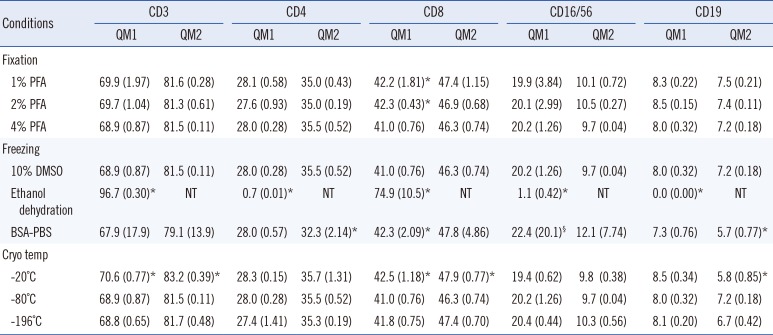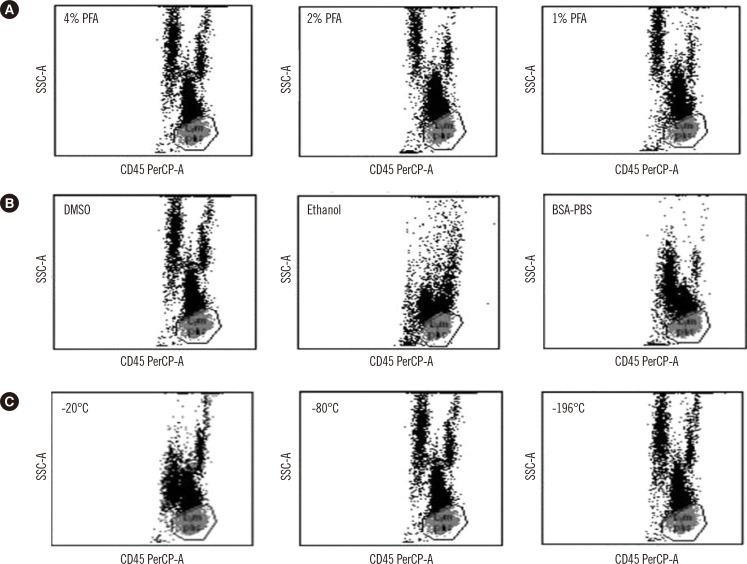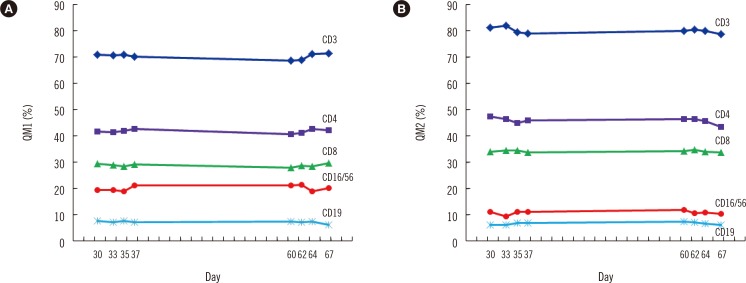Lymphocyte subset analysis is widely used for monitoring treat-ment responses in AIDS patients [
1] and in patients on immunosuppressive therapy (e.g. Rituximab) [
2]. More than two levels of internal quality control (QC) materials should be tested per run for reliable results [
34]. Although QC materials are commercially available, they may not be practically feasible in resource-poor settings such as small clinical laboratories owing to their high costs (approximately 200 USD/50 tests) and short shelf lives (less than 30 days) [
5]. Cell suspensions fixed with 4% paraformaldehyde (PFA) are known to remain stable for several days [
6], and fixed cells cryopreserved at -80℃ for 18 days showed sustained antigenicity for lymphocyte subset analysis after thawing [
7]. There are some reports regarding the development of QC materials by using whole blood [
89], but their use is limited because the fixation method is patented. In this study, we compared different methods for preparing internal QC materials for lymphocyte subset analysis and assessed the stability of the internal QC materials prepared using one of these experimental conditions.
Peripheral blood samples from single healthy donor and three residual blood samples used for lymphocytes subset analysis were pooled to prepare two kinds of QC materials with different levels (QM1 and QM2, respectively). Informed consent was obtained from the donor, and the study design and protocols were reviewed by Institutional Review Board of Boramae Medical Center (16-2014-57). Peripheral blood mononuclear cells (PBMCs) were isolated by the Ficoll-Hypaque density gradient method and fixed with 1%, 2%, or 4% PFA. Because "4% PFA fixation" showed the best discrimination of cell populations and significantly different CD8 fraction compared with "1% or 2% PFA" (all
P<0.05), we chose it as a fixation condition for the experiments of freezing and storage temperature. Cell suspensions fixed with 4% PFA were frozen by three different methods: (1) by using 10% dimethylsulfoxide (DMSO) in complete RPMI media (10% FBS, 2mM L-glutamine, 100 U/mL penicillin, and 100 µg/mL streptomycin sulfate; Life Technologies, Grand Island, NY, USA) [
10], (2) gradual dehydration using ethanol (50%, 70%, 95%, and 100% ethanol for 5 min each), and (3) freezing with 0.1% bovine serum albumin (BSA)-phosphate buffered saline (PBS) without any cryoprotectant. PBMCs fixed with 4% PFA and frozen with 10% DMSO in complete RPMI (cRPMI) were stored at -20℃ for 4 hr in a polystyrene-foam box, and then at -20℃, -80℃, or at -196℃ in a liquid nitrogen tank until thawed for lymphocyte subset analysis. After 4, 6, 8, 11, 13, and 15 days of cryopreservation, PBMCs were thawed at 37℃ in water bath and resuspended with 0.1% BSA-PBS.
Lymphocyte subset was measured with BD Multitest IMK kit (BD biosciences, San Jose, CA, USA) according to the manufacturer's instruction and analyzed with FACSCanto II flow cytometer (BD biosciences, San Jose, CA, USA) on day 0, 4, 6, 8, 11, 13, and 15. Mean, SD, and CV for positive fractions of each antigen (CD3, CD4, CD8, CD19, and CD16/CD56) at days 4, 6, 8, 11, 13, and 15 in each QC material (QM1 and QM2) were calculated for every preparation condition. The Kruskal-Wallis test and Wilcoxon signed rank test were used to analyze the effects of different preparation methods (PFA concentration, freezing method, and cryopreservation temperature). All statistical analyses were performed with SPSS version 21.0 program (IBM Inc., Armonk, NY, USA). The level of significance was set at P<0.05.
At day 0 (before preparation), the lymphocyte subsets in QM1 showed 76.5% CD3, 33.8% CD4, 45.0% CD8, 14.9% CD16/56, and 8.1% CD19 positive cells, and those in QM2 showed 79.7% CD3, 35.5% CD4, 40.4% CD8, 11.2% CD16/56, and 3.6% CD19 positive cells. Only the CD4 fraction of QM1 was significantly decreased after the preparation procedure and thawing compared with the results of day 0 (26.1% vs. 33.8%, P=0.04).
In QM1, the CD3, CD16, and CD19 fractions showed significant differences among the various preparation methods (
P = 0.01, 0.049, and 0.005, respectively). For PFA fixation, using 1% or 2% PFA showed a higher CD8 fraction than fixation with 4% PFA (all
P<0.05) (
Table 1). For the freezing method, ethanol dehydration showed higher CD3 and CD8 fractions with lower CD16/56 and CD19 fractions compared with freezing with 10% DMSO-cRPMI (all
P<0.05). Freezing with BSA-PBS showed a higher CD8 fraction than that with 10% DMSO-cRPMI (
P<0.05). Using a cryopreservation temperature of -20℃ resulted in higher CD3 and CD8 fractions than using -80℃ (all
P<0.05) (
Table 1).
Table 1
Lymphocyte subset results [mean (CV %)] according to different preparation methods (PFA concentration, freezing method, and cryopreservation temperature)

|
Conditions |
CD3 |
CD4 |
CD8 |
CD16/56 |
CD19 |
|
QM1 |
QM2 |
QM1 |
QM2 |
QM1 |
QM2 |
QM1 |
QM2 |
QM1 |
QM2 |
|
Fixation |
|
|
|
|
|
|
|
|
|
|
|
1% PFA |
69.9 (1.97) |
81.6 (0.28) |
28.1 (0.58) |
35.0 (0.43) |
42.2 (1.81)*
|
47.4 (1.15) |
19.9 (3.84) |
10.1 (0.72) |
8.3 (0.22) |
7.5 (0.21) |
|
2% PFA |
69.7 (1.04) |
81.3 (0.61) |
27.6 (0.93) |
35.0 (0.19) |
42.3 (0.43)*
|
46.9 (0.68) |
20.1 (2.99) |
10.5 (0.27) |
8.5 (0.15) |
7.4 (0.11) |
|
4% PFA |
68.9 (0.87) |
81.5 (0.11) |
28.0 (0.28) |
35.5 (0.52) |
41.0 (0.76) |
46.3 (0.74) |
20.2 (1.26) |
9.7 (0.04) |
8.0 (0.32) |
7.2 (0.18) |
|
Freezing |
|
|
|
|
|
|
|
|
|
|
|
10% DMSO |
68.9 (0.87) |
81.5 (0.11) |
28.0 (0.28) |
35.5 (0.52) |
41.0 (0.76) |
46.3 (0.74) |
20.2 (1.26) |
9.7 (0.04) |
8.0 (0.32) |
7.2 (0.18) |
|
Ethanol dehydration |
96.7 (0.30)*
|
NT |
0.7 (0.01)*
|
NT |
74.9 (10.5)*
|
NT |
1.1 (0.42)* |
NT |
0.0 (0.00)*
|
NT |
|
BSA-PBS |
67.9 (17.9) |
79.1 (13.9) |
28.0 (0.57) |
32.3 (2.14)*
|
42.3 (2.09)*
|
47.8 (4.86) |
22.4 (20.1)§
|
12.1 (7.74) |
7.3 (0.76) |
5.7 (0.77)*
|
|
Cryo temp |
|
|
|
|
|
|
|
|
|
|
|
-20℃ |
70.6 (0.77)*
|
83.2 (0.39)*
|
28.3 (0.15) |
35.7 (1.31) |
42.5 (1.18)*
|
47.9 (0.77)*
|
19.4 (0.62) |
9.8 (0.38) |
8.5 (0.34) |
5.8 (0.85)*
|
|
-80℃ |
68.9 (0.87) |
81.5 (0.11) |
28.0 (0.28) |
35.5 (0.52) |
41.0 (0.76) |
46.3 (0.74) |
20.2 (1.26) |
9.7 (0.04) |
8.0 (0.32) |
7.2 (0.18) |
|
-196℃ |
68.8 (0.65) |
81.7 (0.48) |
27.4 (1.41) |
35.3 (0.19) |
41.8 (0.75) |
47.4 (0.70) |
20.4 (0.44) |
10.3 (0.56) |
8.1 (0.20) |
6.7 (0.42) |

In QM2, the CD3, CD4, and CD19 fractions showed significant differences among various preparation conditions (P=0.006, 0.005, and 0.001, respectively). In the freezing methods, freezing with BSA-PBS showed lower CD4 and CD19 fractions than freezing with 10% DMSO-cRPMI (all P<0.05). A cryopreservation temperature of -20℃ resulted in higher CD3, CD8, and CD19 fractions than -80℃ (all P<0.05).
Lymphocyte subsets were determined by dot plots. The discrimination patterns in dot plots of samples cryopreserved at -80℃ and -196℃ looked similar (
Fig. 1), and results of lymphocyte subset analysis at -80℃ and -196℃ were not statistically different (
Table 1).
 | Fig. 1
Example dot plot showing lymphocyte subset analysis according to different preparation methods performed at day 4. (A) Paraformaldehyde concentration for fixation, (B) freezing method, and (C) cryopreservation temperature.
Abbreviations: PFA, paraformaldehyde; DMSO, dimethyl sulfoxide; BSA-PBS, bovine serum albumin-phosphate buffered saline.

|
Considering above experimental data, we selected the optimal preparation conditions as "fixation with 4% PFA, freezing with 10% DMSO, and cryopreservation at -80℃." To evaluate the long-term stability of the QC materials, QM1 and QM2 were prepared by fixation with 4% PFA and freezing with 10% DMSO, and were stored at -80℃. QM1 and QM2 were thawed on days 30, 33, 35, 37, 60, 62, 64, and 67. Lymphocyte subset was analyzed after resuspension in 0.1% BSA-PBS. The Friedman test was used to evaluate variations in repeated measures and trends over time.
Repeated measures performed on days 30, 33, 35, 37, 60, 62, 64, and 67 did not show any statistical differences or trends (
Fig. 2). CV (%) of lymphocyte subset analysis after 30-67 days of cryopreservation was less than 3% for CD3, CD4, and CD8 and ranged from 5% to 7% for CD16/56 and CD19.
 | Fig. 2
Lymphocyte subset analysis after 30-67 days of cryopreservation in QM1 and QM2.
Abbreviation: QM, quality control material.

|
Commercially available QC materials for lymphocyte subset analysis are expensive, have short shelf lives, and may be not practical for use in resource-poor settings. We compared different preparation conditions for homemade QC materials for lymphocyte subset analysis and selected one experimental condition (fixation with 4% PFA, freezing with 10% DMSO, and cryopreservation at -80℃) for evaluation of long-term stability of the prepared QC materials. Considering the difficulty in maintaining liquid nitrogen tanks in resource-poor settings, we chose -80℃ as the experimental condition of choice.
QC materials prepared according to the present experimental conditions showed good stability after two months of cryopreservation (CV<7%). Stability after longer periods of storage (such as six months or one year) needs to be confirmed in further studies. We suggest that the present experimental condition (fixation with 4% PFA, freezing with 10% DMSO, and storage at 80℃) form a cost-effective preparation method for homemade QC materials to be used for lymphocyte subset analysis.
Although the comparison with commercial QC materials was not included, this study is meaningful to prepare feasible QC material using peripheral blood and residual samples. This method can be used in small clinical laboratories and in resource-poor settings to improve the quality of flow cytometric lymphocyte subset analysis.






 PDF
PDF ePub
ePub Citation
Citation Print
Print



 XML Download
XML Download